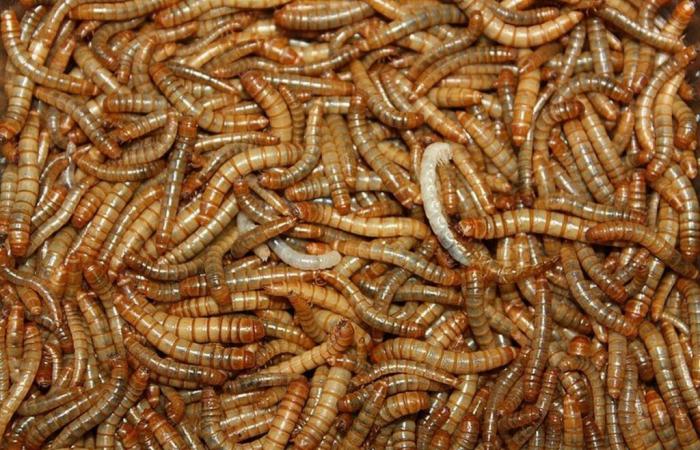They join a small group of insects capable of breaking down polluting plastic, but this is the first time an insect species native to Africa has been able to do so.
Polystyrene, commonly known as Styrofoam, is a plastic material widely used in food, electronics and industrial packaging. It is difficult to decompose and therefore durable. Traditional recycling methods, such as chemical and thermal processing, are expensive and can generate pollutants. This is one of the reasons why we wanted to explore biological methods of managing this persistent waste.
I’m part of a team of scientists at the International Center for Insect Physiology and Ecology who discovered that the larvae of the little Kenyan mealworm can chew polystyrene and harbor bacteria in their intestines that help break down the material.
The little mealworm is the larval form of the beetle Alphitobius. The larval period lasts between 8 and 10 weeks. The small mealworm is mainly found in chicken coops where warm conditions and a constant supply of food allow them to grow and reproduce.
Although little mealworms are thought to have originated in Africa, they are found in many countries around the world. The species that we identified in our study could, however, be a subspecies of the genus Alphitobius. We are continuing our research to confirm this hypothesis.
Our study also focused on the insect’s intestinal bacteria. We wanted to identify bacterial communities likely to promote the plastic degradation process.
Plastic pollution is reaching critical thresholds in some African countries. Although plastic waste is a major environmental problem globally, Africa faces a particular challenge due to the massive importation of plastic products, their low reuse and lack of recycling of these products.
By studying these natural “plastic eaters,” we hope to create new tools that will help us get rid of plastic waste faster and more efficiently. Instead of releasing large numbers of these insects into landfills (which is impractical), we can use the microbes and enzymes they produce in factories, landfills, and cleanup sites. This would allow waste to be processed more easily and on a large scale.
Main findings
We carried out a trial which lasted more than a month. Larvae were fed either only polystyrene or bran (a nutrient-rich food) alone, or a combination of polystyrene and bran.
We found that mealworms fed polystyrene and bran survived longer than those fed polystyrene alone. We also observed that they consumed polystyrene more efficiently than those fed only polystyrene. This highlights the benefits of a nutrient-rich diet for insects.
Although the polystyrene diet allowed the mealworms to survive, they did not have enough nutrients to effectively break down the polystyrene. This finding highlights the importance of a balanced diet so that insects can optimally consume and degrade plastic. Insects could eat polystyrene because it is mostly carbon and hydrogen, which could provide them with a source of energy.
Mealworms fed polystyrene-branch were able to decompose approximately 11.7% of total polystyrene during the test period.
Intestinal bacteria
Analysis of the mealworm gut revealed significant changes in bacterial composition depending on diet. Understanding these changes in bacterial composition is critical because they help identify which microbes are actively involved in plastic breakdown. This will help us isolate specific bacteria and enzymes that can be exploited in plastic degradation efforts.
The intestines of larvae fed polystyrene contained more Proteobacteria and of Firmicutesbacteria capable of adapting to diverse environments and breaking down a wide range of complex substances. Bacteria such as Kluyvera, Lactococcus, Citrobacter et Klebsiella were also particularly abundant and are known to produce enzymes capable of digesting synthetic plastics. The bacteria will not be harmful to the insect or the environment if used on a large scale.
The abundance of bacteria indicates that they play a crucial role in breaking down plastic. This could mean that mealworms do not naturally have the ability to eat plastic. On the other hand, when they start eating plastic, the bacteria in their intestines may change to help break it down. So microbes in the stomachs of mealworms can adapt to unusual diets, such as plastic.
These results confirm our hypothesis that the intestine of certain insects can allow the degradation of plastic. This is likely because bacteria in their gut can produce enzymes that break down plastic polymers.
It is therefore possible to isolate these bacteria and the enzymes they produce in order to create microbial solutions that will make it possible to treat plastic waste on a larger scale.
Next steps
Certain species of insects, such as the yellow mealworm (The Dark One) and the super worm (Zophobas morio), have already demonstrated their ability to consume plastic. They are able to break down materials such as polystyrene with the help of bacteria in their intestines.
Our research is unique because it focuses on insect species native to Africa, which have not been studied extensively in the context of plastic degradation.
This regional approach is important because insects and environmental conditions in Africa may differ from those in other parts of the world, which could offer new insights and practical solutions to plastic pollution in African environments.
The Kenyan mealworm’s ability to consume polystyrene suggests it could play a role in natural waste reduction, particularly for types of plastic that are resistant to conventional recycling methods.
Future studies could focus on isolating and identifying specific bacterial strains involved in polystyrene degradation and examining their enzymes.
We hope to determine whether the enzymes can be produced on a large scale for waste recycling.
Additionally, we could explore other types of plastics to test the versatility of this insect for broader waste management applications.
Larger-scale use of small mealworms for plastic degradation would also require strategies to ensure insect health during prolonged plastic consumption, as well as assessing the safety of insect biomass resulting for animal feed.






